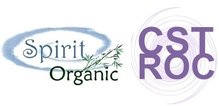A first time visitor to an exhibition of the work of Waldorf pupils is usually particularly struck by the paintings. They make an unusual impression. The first perception is of strong, shining primary or mixed colors that are fundamentally translucent. These pictures have various different color moods. The colors appear to be hovering, they are not dense like colors that are attached to physical objects. The surfaces of color are not confined within contours, there are no outlines. The colors can move about unhindered and blend or become consolidated at will. They do not seem to be fixed to the surface, but seem to come to meet us or draw away from us...
(excerpt from "Drawing & Painting in Waldorf Schools")
Watercolor painting, form drawing with block or thin beeswax crayons, beeswax modeling: These may be considered by some to be art education. Indeed, I have heard grumbling by some of the students that these activities do not allow them enough realism for their art. While I cannot pose to be any sort of expert on Waldorf methods or Rudolf Steiner's philosophy, I'd like to take a stab at explaining why the above activities are not meant to be art at all, but are another vehicle for our children's growth and spiritual integration.
Central to Waldorf principles is the need to surround children with beauty. Watercolors and beeswax crayons (when used with teacher guidance and purpose) naturally create very beautiful works without technical talent. You will notice that the teachers use care not to allow the children to muddle their colors into a brown mess. At home our children may find joy creating many shades of brown and black in their artistic pursuits, but at the Waldorf school there is a grander purpose than just learning that mixing all of the colors makes mud.
Watercolor paints remind me of the silk scarves Waldorf parents are encouraged to use as drapes over their babies' cradles. When children are small, their perception of the physical world is still veiled. Most young children are not able to perceive strict realism. They are still emerging from their spiritual womb. This emergence will continue until the child is well into adulthood. As a matter of fact, Waldorf philosophy is quite emphatic that to push a child into realism (through premature reading or denial of fantasy play) can cripple their spiritual development.
Working with beeswax is a very sensual experience. The smell of the wax, the feel of it softening in the hand, the shimmering color all create a pleasurable atmosphere for the exploration of three dimensional creation. The children listen to their teacher's story and manifest an element from the story with their own hands. Watercolor paints and beeswax crayons allow the child to create without literalism. They are continually pushed away from the inside of arbitrary boundaries to the radiating form. In this way children are taught that they do not need to confine themselves, their thoughts or the others around themselves into a preconceived box or how things/people are supposed to be configured.
As with the stories being told to the children, the forms they are being taught have nothing to do with literal representation. The forms are meant to resonate with the child's state of development, to assist with the brain's integration of the surrounding world. The forms, the paintings, the beeswax sculptures all assist in the maturation of the spirit/emotion/body. The fact that the results are beautiful objects or pictures is a lovely by-product, NOT the primary goal.


 RSS Feed
RSS Feed